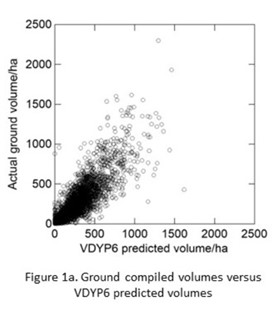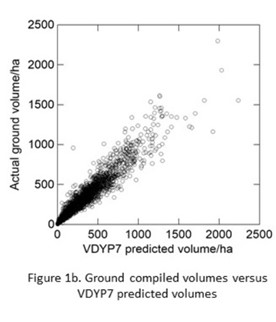VDYP - growth relationships and model components
Biometrics overview of Variable Density Yield Projection (VDYP7) components
This document provides an overview of the VDYP7 system from a functional biometrics perspective. From that perspective there are a number of major components to VDYP7; some are empirical and others are algorithmic. All the major components are described here. The purpose of the document is to provide the user with an understanding of what the major components of VDYP7 do, and how they interact. This will be useful in understanding how system outputs relate to the inputs, and why the system behavior for VDYP7 may sometimes be quite different from that of VDYP6.
A comparison of the interfaces that use VDYP7 core modules
The VDYP7 Core Modules are utilized within four different User Interfaces: WinVDYP, VDYP7 Console, VDYP7 Growth Projection within VRIMS, and VDYP7 Attribute Adjustment (VDYP7_ADJUST). It should be noted that there are differences in how the modules operate within each of these interfaces, particularly within WinVDYP7.
Advantages and limitations
VDYP7 addresses the weaknesses of its predecessor and provides many advantages:
It is a true growth model:
- Yields are projected by incrementing density attributes including basal area and quadratic mean diameter, rather than only incrementing age and growing height
More accurate measurement of stand density:
- VDYP7 uses basal area as a direct measure of stand density. As a result, the model is more sensitive to changes in stand density and can be used to model catastrophic mortality (For example, stands affected by mountain pine beetle), or selectively harvested stands
Estimation of average stand diameter:
- VDYP7 can produce quadratic mean diameters for all stands in a management unit. In the future, this will facilitate the estimation of stand-level stand structure attributes, such as piece size, for industry
More flexible yield reporting:
- VDYP7 generates a wider variety of outputs than VDYP6. Five different volume types (whole stem volume; close utilization; close utilization net decay; close utilization net decay and waste; and close utilization net decay, waste and breakage) are generated at five different diameter limits (4.0 cm+, 7.5 cm+, 12.5 cm+, 17.5 cm+, and 22.5 cm+). The 4.0 cm+ diameter limit allows for more accurate estimation of forest biomass
Ecologically-based growth and yield functions:
- VDYP7 growth and yield functions are fitted based on Biogeoclimatic Ecosystem Classification (BEC) zones. This is consistent with the ecologically-based taper equations and loss factors that predict more accurate volumes. VDYP6 was based on forest inventory zone (FIZ)
More accurate predictions due to additional attribute inputs:
- When there are no errors in attributes, VDYP7 predicts more accurate volume yields. Figures 1a and 1b show ground-compiled volumes plotted against VDYP6 and VDYP7 predicted volumes. VDYP6 inputs include: height, age, crown closure and stocking class, whereas VDYP7 inputs include: site height, age, Lorey height, basal area, and trees per hectare. From these figures, it is evident that VDYP7 is a better predictor of volume than VDYP6


Although there are distinct advantages to using VDYP7 relative to VDYP6, users should be aware of the following challenges with VDYP7. Efforts are being made to address these challenges:
VDYP7 Console requires eight .csv input attribute tables; more than required in VDYP6:
- Attributes describing vegetation and non-vegetation layers, history, etc. are required. Users need to establish specific table structures that will store the inputs. If these tables are not established accurately, the model will not run
VDYP7 Attribute Adjustment requires a working knowledge of MS Access computer programming language:
- This language has limitations in processing a large number of records
Short, young stands may not return any yields:
- This is largely dependent on a stand’s quadratic mean diameter. Stands that are less than 6-8 m in height and that do not meet the 7.5 cm quadratic mean diameter criteria, will not be assigned volumes
Very low site index polygons that were assigned volumes in VDYP6 may not necessarily be assigned volumes in VDYP7 until they become older than approximately 100 years:
- Sometimes, VDYP7 returns null values, for example, no volumes for these stands
VDYP7 Attribute Adjustment requires a very specific database format for load into the VRIMS environment:
- The format of the personal geo-database (PGDB) is specified in the document, VDYP7 Attribute Adjustment Procedures Manual (currently not available)
